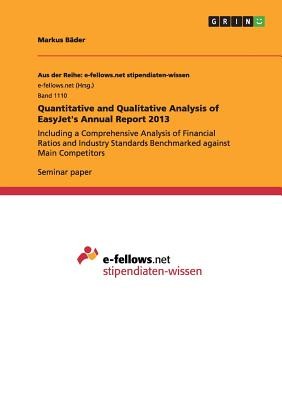
- We will send in 10–14 business days.
- Author: Markus Bäder
- Publisher: GRIN Verlag
- ISBN-10: 3656892237
- ISBN-13: 9783656892236
- Format: 14.8 x 21 x 0.3 cm, minkšti viršeliai
- Language: English
- SAVE -10% with code: EXTRA
Quantitative and Qualitative Analysis of EasyJet's Annual Report 2013 (e-book) (used book) | bookbook.eu
Reviews
Description
Seminar paper from the year 2015 in the subject Business economics - Accounting and Taxes, grade: 1,0, University of Newcastle, language: English, abstract: Luton-based EasyJet is UK's largest low-cost airline, employing 8,945 people and carrying 61m passengers annually. EasyJet follows Porter's low-cost strategy, effectively distinguishing itself from other LCCs by competing against established flag-carriers at primary European airports. The company streamlines its operations to cost-reduction, facilitated by a strong capital structure. Europe's airline industry has experienced a structural change since the recession in 2009, with major legacy-carrier continuously reducing their short-haul-capacity. Simultaneously, a KPMG study revealed that the cost gap between traditional and budget airlines has recently shrunk by 30%. EasyJet's business model distinctly differs from LCC-pioneer Ryanair as the Irish have strategically built a route network focused on serving secondary airports and thereby managed to keep the cost per seat 50% below EasyJet. However the Britons cost-control strategy resulted in a 48% favourable cost base compared to competing legacycarrier such as IAG.
EXTRA 10 % discount with code: EXTRA
The promotion ends in 21d.08:44:22
The discount code is valid when purchasing from 10 €. Discounts do not stack.
- Author: Markus Bäder
- Publisher: GRIN Verlag
- ISBN-10: 3656892237
- ISBN-13: 9783656892236
- Format: 14.8 x 21 x 0.3 cm, minkšti viršeliai
- Language: English English
Seminar paper from the year 2015 in the subject Business economics - Accounting and Taxes, grade: 1,0, University of Newcastle, language: English, abstract: Luton-based EasyJet is UK's largest low-cost airline, employing 8,945 people and carrying 61m passengers annually. EasyJet follows Porter's low-cost strategy, effectively distinguishing itself from other LCCs by competing against established flag-carriers at primary European airports. The company streamlines its operations to cost-reduction, facilitated by a strong capital structure. Europe's airline industry has experienced a structural change since the recession in 2009, with major legacy-carrier continuously reducing their short-haul-capacity. Simultaneously, a KPMG study revealed that the cost gap between traditional and budget airlines has recently shrunk by 30%. EasyJet's business model distinctly differs from LCC-pioneer Ryanair as the Irish have strategically built a route network focused on serving secondary airports and thereby managed to keep the cost per seat 50% below EasyJet. However the Britons cost-control strategy resulted in a 48% favourable cost base compared to competing legacycarrier such as IAG.


Reviews